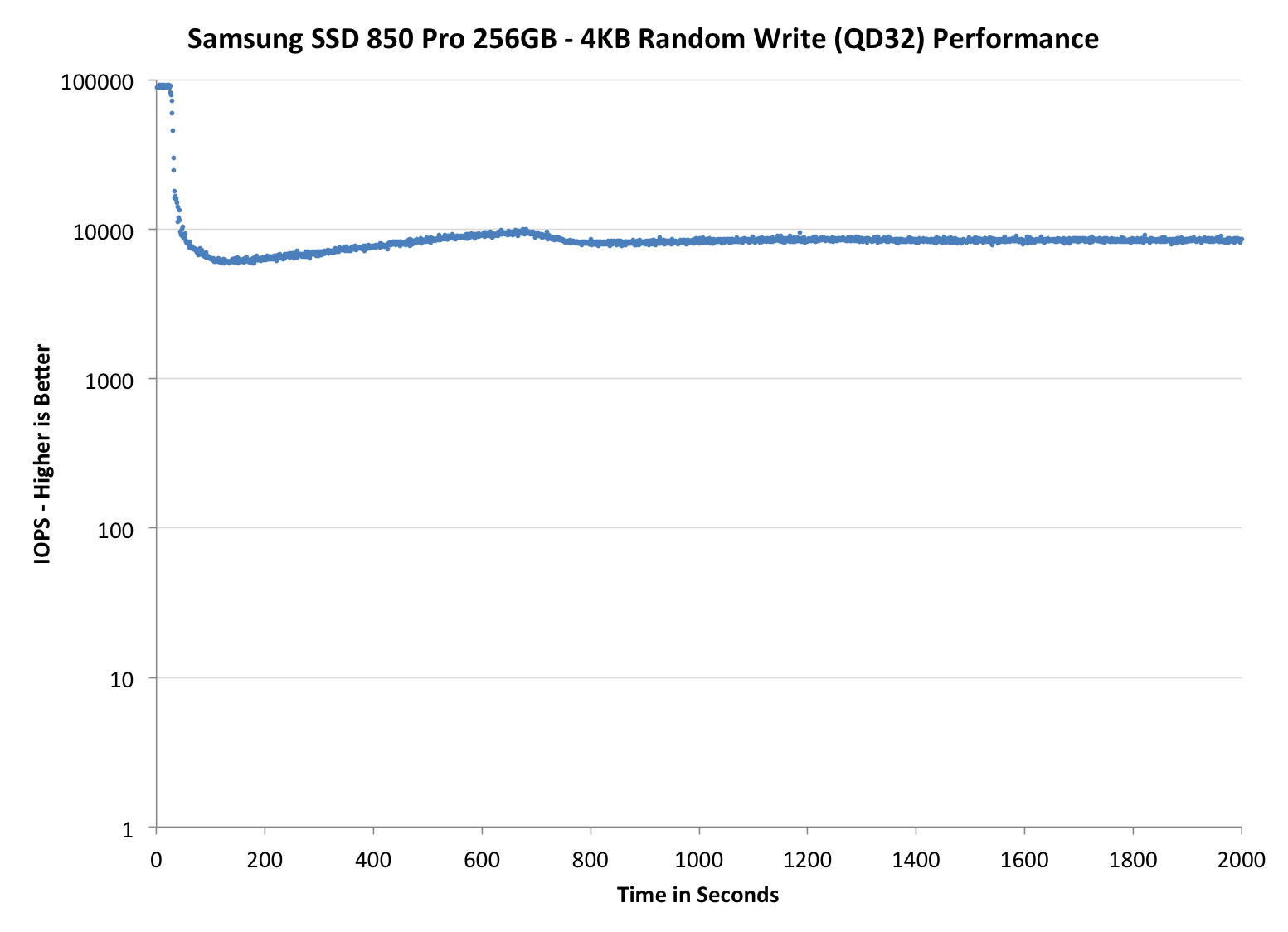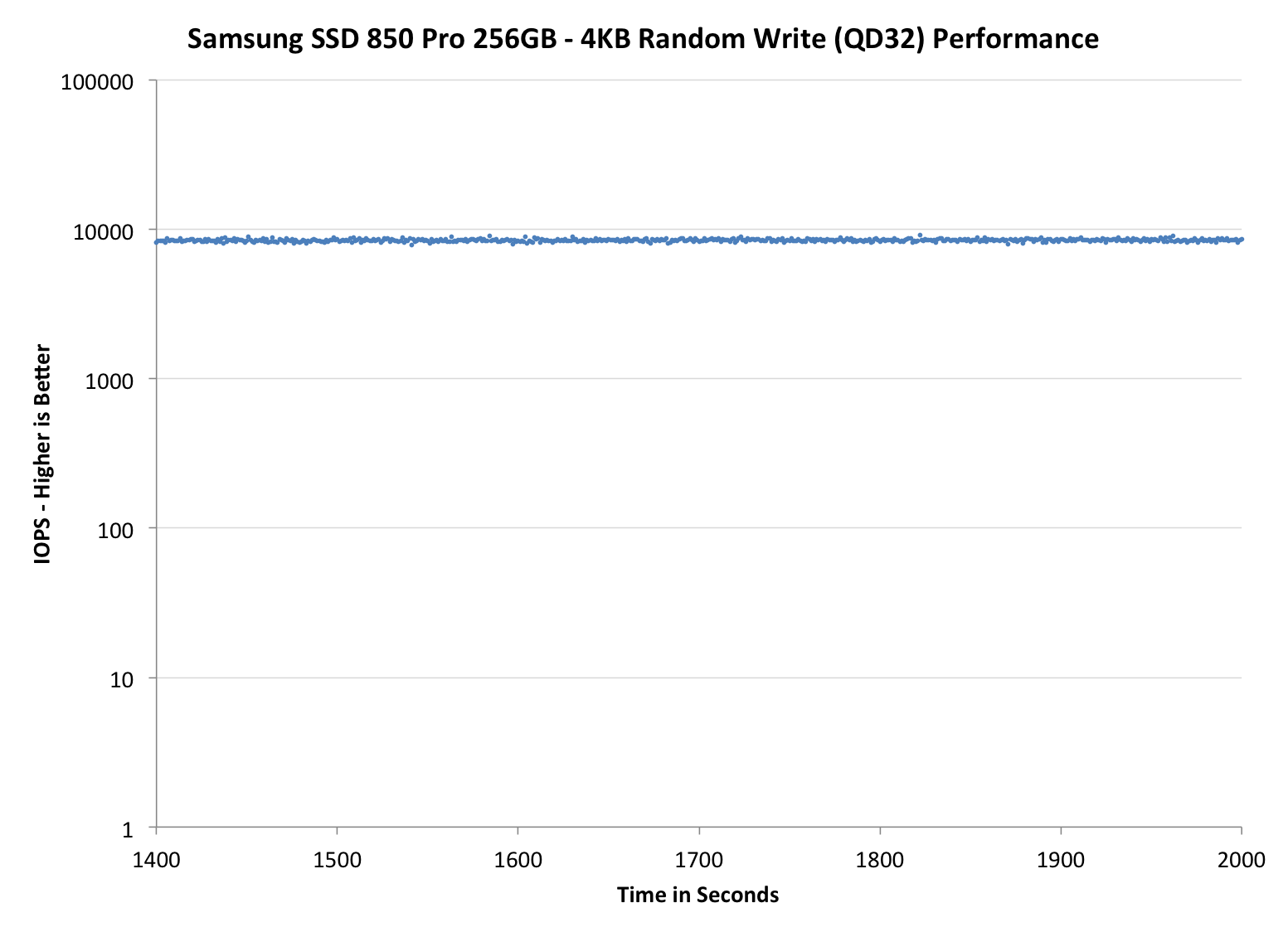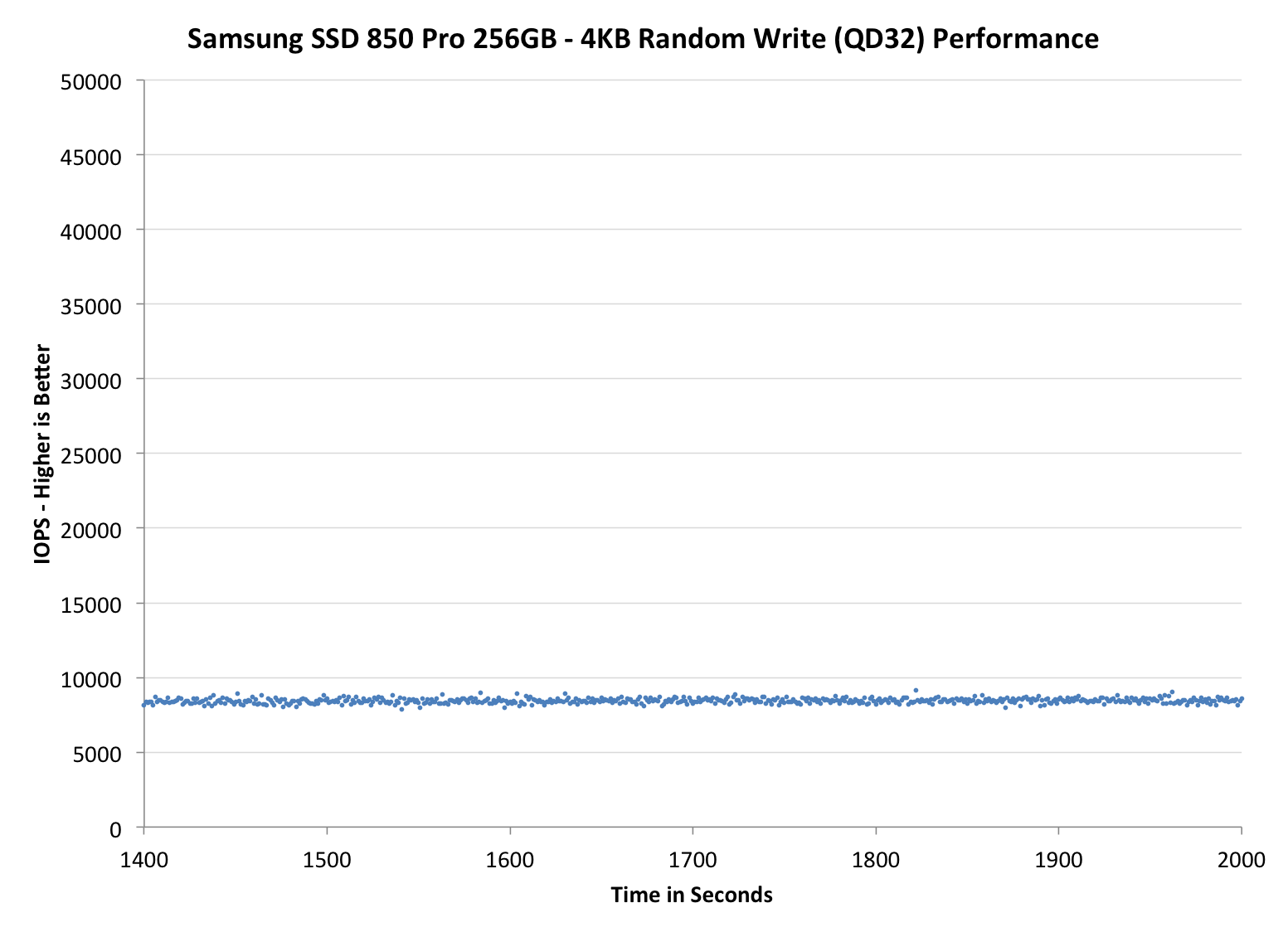Samsung SSD 850 Pro (128GB, 256GB & 1TB) Review: Enter the 3D Era
by Kristian Vättö on July 1, 2014 10:00 AM ESTPerformance Consistency
Performance consistency tells us a lot about the architecture of these SSDs and how they handle internal defragmentation. The reason we don’t have consistent IO latency with SSD is because inevitably all controllers have to do some amount of defragmentation or garbage collection in order to continue operating at high speeds. When and how an SSD decides to run its defrag or cleanup routines directly impacts the user experience as inconsistent performance results in application slowdowns.
To test IO consistency, we fill a secure erased SSD with sequential data to ensure that all user accessible LBAs have data associated with them. Next we kick off a 4KB random write workload across all LBAs at a queue depth of 32 using incompressible data. The test is run for just over half an hour and we record instantaneous IOPS every second.
We are also testing drives with added over-provisioning by limiting the LBA range. This gives us a look into the drive’s behavior with varying levels of empty space, which is frankly a more realistic approach for client workloads.
Each of the three graphs has its own purpose. The first one is of the whole duration of the test in log scale. The second and third one zoom into the beginning of steady-state operation (t=1400s) but on different scales: the second one uses log scale for easy comparison whereas the third one uses linear scale for better visualization of differences between drives. Click the buttons below each graph to switch the source data.
For more detailed description of the test and why performance consistency matters, read our original Intel SSD DC S3700 article.
 |
|||||||||
| Samsung SSD 850 Pro | Samsung SSD 840 Pro | SanDisk Extreme Pro | Intel SSD 730 | OCZ Vector 150 | |||||
| 7% Over-Provisioning | - | - | - | ||||||
| 12% Over-Provisioning | |||||||||
| 25% Over-Provisioning | |||||||||
Wow, this is awesome. Even with the default 7% over-provisioning, the 850 Pro is pushing almost as many IOPS as the Extreme Pro with its 12% over-provisioning. When the over-provisioning is increased to the same 12% level, the 850 Pro is a leader without a doubt. Only the Vector 150 can come close, although it is nowhere hear as constant as the IOPS is ranging between 10K and 30K, whereas the 850 Pro can maintain a steady line.
When compared with the 840 Pro, the upgrade is tremendous. IO consistency was always the weak point of the 840 Pro, so it is great to see that Samsung has paid a great effort to fix that in the 850 Pro. A part of the performance increase obviously comes from the usage of V-NAND because with shorter program and erase latencies, the steady-state performance increases as the garbage collection takes less time and there are more empty blocks available.
Some of you may wonder the odd capacities at 25% over-provisioning but the reason is that I noticed an error in the old ones. Basically, the old 25% numbers were in gibibytes (i.e. 1024^3 bytes) whereas the other capacities have always been in gigabytes (1000^3 bytes). I decided to unify the capacities and now they are all reported in gigabytes. The actual testing or over-provisioning levels have not changes -- it is simply a matter of how the capacities are represented.
 |
|||||||||
| Samsung SSD 850 Pro | Samsung SSD 840 Pro | SanDisk Extreme Pro | Intel SSD 730 | OCZ Vector 150 | |||||
| 7% Over-Provisioning | - | - | - | ||||||
| 12% Over-Provisioning | |||||||||
| 25% Over-Provisioning | |||||||||
 |
|||||||||
| Samsung SSD 850 Pro | Samsung SSD 840 Pro | SanDisk Extreme Pro | Intel SSD 730 | OCZ Vector 150 | |||||
| 7% Over-Provisioning | - | - | - | ||||||
| 12% Over-Provisioning | |||||||||
| 25% Over-Provisioning | |||||||||










160 Comments
View All Comments
TrackSmart - Tuesday, July 1, 2014 - link
I second this. The Anandtech SSD tests were designed so that we could tell the difference between drives that are all so fast - that there is no way to tell them apart in ordinary usage scenarios. I see the value of testing the theoretical performance of drives as manufacturers push the technological limits.That said, at the end of the day user-experience is what matters. I agree with emn13 that the "light workload" test is already more strenuous than anything the average user is likely to do, and looking at the chart, we see that almost every drive is within a range of ~280 to ~380 MB/s. I'm guessing that the range in performance gets even narrower for "real world" workloads.
So keep up the innovative SSD testing, but be sure to put these theoretical performance gains into a real-world context when you get to the Conclusions section of these articles. Not everyone will benefit from these theoretical increases in performance.
hojnikb - Tuesday, July 1, 2014 - link
Is Samsung planning on doing TLC based V-NAND anytime soon ?It would be great for a mainstream drive, since endurance would be higher (due to older node), speeds would probobly also went up (so no need for gimicks like turbowrite).
Or is it not mature enough to scale down to TLC ?
artifex - Tuesday, July 1, 2014 - link
You had me at 10 years warranty. I don't mind the slight premium if I'm not buying another one midway through the cycle. Sure, it will be obsolete well before it dies, but that term signals Samsung is really confident about their reliability.Gigaplex - Tuesday, July 1, 2014 - link
Since it's twice the price of competition like the MX100, you're better off replacing mid way through the cycle.Arnulf - Tuesday, July 1, 2014 - link
I must have missed this in the article - are these V.NAND cells as used in 850 Pro drives 2 or 3 bits per cell ? I got the "larger lithography improves endurance" part, I'm just wondering whether they opted for more conservative option (MLC) there as well.extide - Tuesday, July 1, 2014 - link
These are MLC, or 2 bit per cell.It would be interesting if the non pro 850 comes out with TLC V-NAND!
himem.sys - Tuesday, July 1, 2014 - link
Heh, we are waiting for tests 850pro vs 840pro, because there are no bigger differences "on paper".sirvival - Tuesday, July 1, 2014 - link
Hi,one question:
In the review the idle power consumption for e.g. the 850 128gig is 35 mw.
I wanted to compare that to my Samsung 470 so I went to Bench and selected the drives for comparison.
There it says that the 850 uses 0.29 Watt.
So how comes there is a difference?
KAlmquist - Tuesday, July 1, 2014 - link
Anandtech Bench has four SSD power numbers:SSD Slumber Power (HIPM+DIPM)
Drive Power Consumption - Idle
Drive Power Consumption - Sequential Write
Drive Power Consumption - Random Write
The confusing things are that (1) the review only listed slumber power, not idle power, and (2) Bench lists both numbers but doesn't place the slumber power next to the other power values.
mutantmagnet - Tuesday, July 1, 2014 - link
I also find the lack of powerloss protection being a big negative over this hard drive. Until REFS has all the features it needs in Windows that you would get in Linux this is going to be an important feature for anyone who values data integrity. Even after that happens it still might be very important.